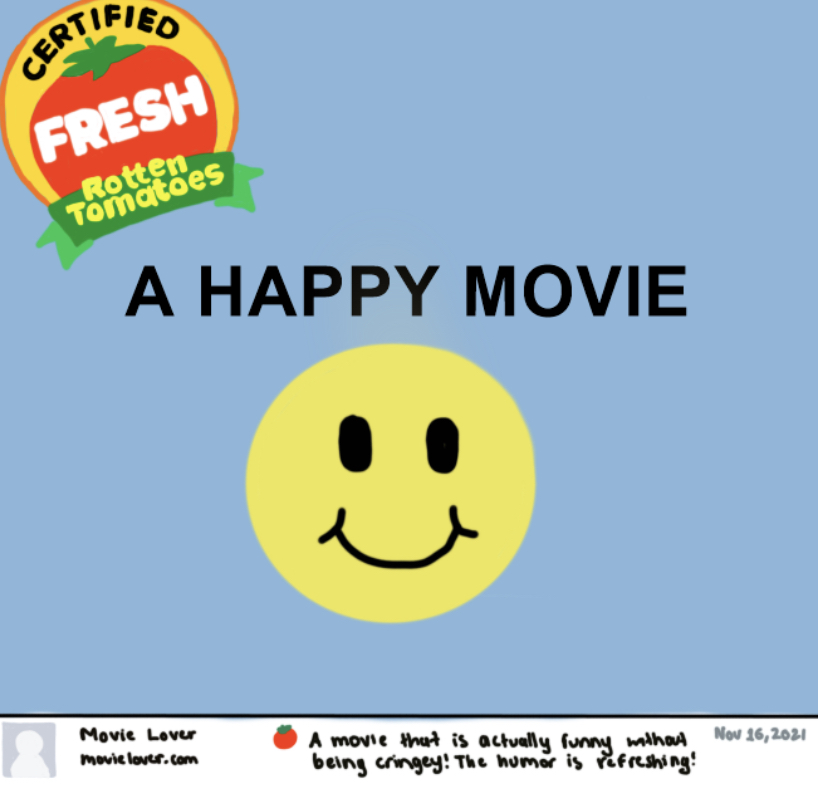Light-hearted films leave audiences unsatisfied
Despite the increase in the number of movies released, good light hearted films are hard to come by.
January 12, 2022
When most people think of cinema classics, “Pulp Fiction,” “The Godfather,” “Dead Poets Society,” “Interstellar,” “Gladiator” and “Titanic” are some common names that pop up. Although some of these movies have comedic elements, the darker elements within them are what have defined them as fan favorites.
As time goes by, the number of movies released has increased steadily. In 2018, the United States released more than 800 movies compared to only 314 in 2000. That’s more than a 159% increase in the number of released movies.
However, the glaring issue of well-produced light-hearted films becomes more prominent. With a lack of well-designed plots, believable characters and thematic consistency, enjoyable light-hearted films that one can watch on a Friday night are hard to come by.
In an interview with The Atlantic, “House of Cards” showrunner Beau Willimon stated that “a good story has conflict.” This “conflict” can only be established from plot. There are four main elements that make up a “good” plot: believable characters, character growth, tension and thematic consistency. Now, the meaning of these words can and will differ from story to story. Nonetheless, these elements need to be present.
To break it down even more, believable characters don’t have to translate to characters that everybody knows like our beloved Harry Potter or Superman, but rather characters that we can empathize with or relate to. Let’s take, for example, “Inception.” This film centers around a group of thieves stealing ideas from people’s brains and manipulating their dreams.
This is a power that no layman could fathom, yet we are still able to connect this to the loss Dom Cobb (Leonardo DiCaprio) faced, the confusion Ariadne (Elliot Page) faced as she learned what dreamsharing was and the frustration Arthur (Joseph Gordon-Levitt) went through when he saw his friend slowly lose himself to trauma.
These characters experienced emotions that any layman could understand. This helps us buy the idea that this world, where people could steal ideas from people’s minds, could in fact exist. All these characters desired something, and stealing ideas from people’s minds was just a tool that they used to achieve this. This rationale is something people could empathize with.
At the same time, if we take the trilogy of “The Kissing Booth,” we see the “believability” of the character dwindling with each passing moment of the movie. Every choice the protagonist, Elle Evans (Joey King) makes doesn’t hold up with rationale that we can understand. Harvard or UC Berkeley? One rich boy or another rich boy? The reasoning behind each decision is based on an experience that we aren’t privy to. The three movies used to describe each choice that Elle makes always contradict each other, furthering the lack of “believability” of the character.
But it isn’t just the lack of believability that makes the trilogy aggravating—it’s also the lack of character growth.
In “To All the Boys I’ve Loved Before” (the first of three movies), we see Peter Kavinsky (Noah Centineo) being overly clingy and irresponsible for the consequences of his own actions. He lies to Lara Jean Covey (Lana Condor) about what he was doing in a hot tub during the school’s ski trip (spoiler alert—he was waiting for another girl). After Lara Jean finds out why he was there and gets angry, he says that it’s her fault that she had high hopes and breaks up with her (but they make-up somehow, because this is a teen rom–com like any other).
In its final movie, “To All the Boys: Always and Forever,” Peter gets mad because Lara Jean wants to pursue her education at NYU and not at UC Berkeley like they had planned. The anger that Peter shows at the sight of Lara Jean protecting herself shows the distinct lack of character development over the three movies.
On the flipside, if we take the “Iron Man” trilogy, we have Tony Stark (Robert Downey Jr.), who has more money than he knows what to do with and wears the name “Merchant of War” with pride. He sells weapons that kill millions without any remorse until he sees the pain and trauma he causes. He gets kidnapped and realizes that he doesn’t want to be the “Merchant of War.” When he gets rescued, the first thing he does is shut down his weapons company (he actually gets a cheeseburger, but those are just details).
The subsequent movies all revolve around him repenting for his past. Despite all the hurdles in the way of his peace, he perseveres and ends his arc by sacrificing himself for the world— a “stark” contrast of how he started his movie.
Character development is key to making stories real and engaging because it drives the story forward. It’s easy to relate to Tony Stark because he struggled and was rewarded for his transformation, but Peter Kavinsky was stuck in the same vicious cycle of being clingy and desperate for control. The lack of character development leads to a lousy story — a very common trait among light-hearted films.
And when there is a lack of character development, thematic consistency isn’t achievable.
Themes are universal truths that are achieved when characters push the plot forward. Themes are divided into topics that are then achieved by the characters; however, most stories lose themselves here.
For example, “He’s All That,” released in 2021, was an utter disaster due to the lack of thematic consistency. Padgett Sawyer (Addison Rae) tries to be the bigger person and transform an antisocial boy to a popular one while simultaneously stating that being different was okay (the irony wasn’t lost on any of us).
The movie falls into the trap of contradicting itself constantly, which makes the plot drag on and inherently hurts the entire experience. The movie either embraces the idea that being different is okay or that society forces us to act in certain ways to fit in. But the movie tries to do too much without any payoff.
In contrast, “The Half of It,” released in 2020, picks a theme and is consistent with it; it doesn’t betray its character to sound more “woke.” Ellie Chu (Leah Lewis) is content with not being seen and makes it very clear that love is very messy. When the movie ends, Ellie is content with being seen but still maintains her opinion that love is messy. In fact, the movie hopes that the audience understands that there is no such thing as “perfect love.” This idea fits right into the other element of the story which revolves around self-discovery and identity.
When the movie establishes that it isn’t about love, we are able to engage more with the characters finding themselves. In this scenario, we are able to understand the emotional roller coaster of feelings that transforms Ellie. This thematic consistency helps to build an engaging plot and a storyline that we can follow.
When all of these elements are present in a story, it becomes very easy to create conflict—mainly because these characters become human. And when something is human, conflict is always an accessory. However, in recent years, this aspect seems to be forgotten when a movie is made.
These elements aren’t exclusive to light-hearted films. It seems like this genre always forgets that just being light-hearted isn’t a good enough reason for the audience to like the movie.
So please, the next time a light-hearted film is released, make sure it has a good plot so viewers don’t waste their Friday nights hoping that what they’re watching makes at least a little sense.






